Ever since we had seen Attila Kapitany do a presentation about Australian desert plants for our Mornington Peninsula Australian Plants group a few years back we had wanted to visit the garden he and his wife Michele have created out at Narre Warren North. The only problem was they only open it up in April and August each year by appointment only. Given Karen has her birthday in April we decided to make a booking then, as August can be pretty bleak during our winter. One of our sons, Lee, and his partner Laura are interested in succulents so they came too along with another friend of Karen’s, Zara.
We were met at the gate by Attila. He guided us down the footpath along the boundary of the garden to a couple of peepholes that had been created in a hedge. Here’s the view into the garden.

From there we were soon guided into the garden.

Even though there are plants from all over the world the focus for us was to see Autstralian native plants as we explored. This row of bottle trees (Brachychitons) stood out out.

Multiple plantings were also a feature of the garden.



Along the way we came to a section Attila called the ‘Ruins’.

Here stones had been stacked up in an artistic manner. It turns out that they were all stones recovered when digging up dirt on the property.
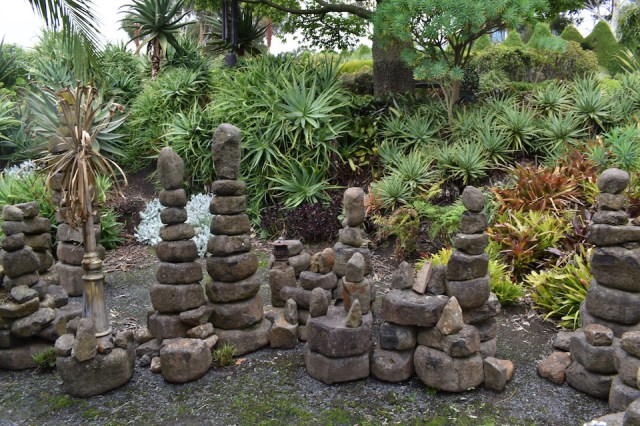
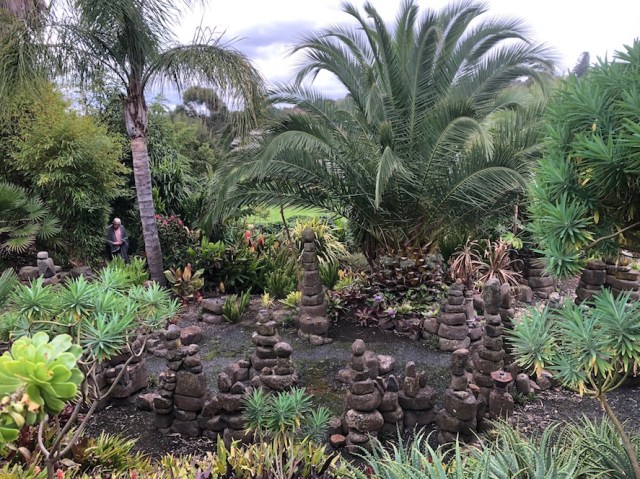
At one edge of the garden we came to another mass planting of Brachychiton rupestris. Even though they are native to Queensland they were still growing well here.

Nearby we came to another similar tree but which had spikes on the trunk. I think it was a Ceiba but can’t recall exactly what Attila said. The spikes were certainly pointy!

Just about every way we looked I could frame a photo. Here’s another snap I like.

One plant we did know the name of was this group of Aloe veras.
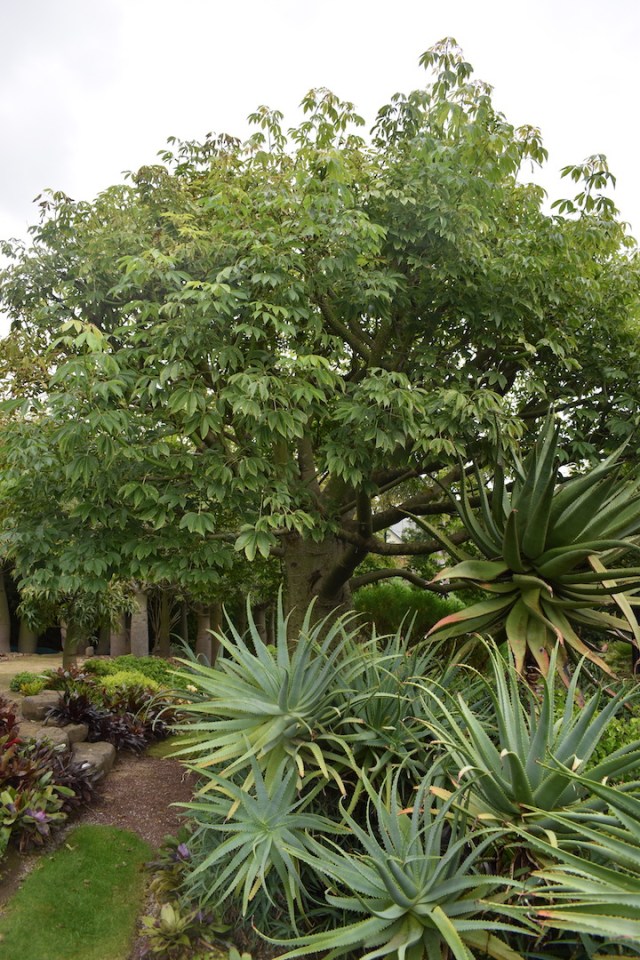
A lot of the trail was gravel but we did come to some sections of lawn.

Here we could see how densely growing the succulents were. (No room for weeds, we noted.) Apparently Michelle has propagated many of them from cuttings and division. Here’s a view back to the windows we had looked through at the start of the tour.

The idea being they would create a river of succulents as they grew down the slope of the garden.
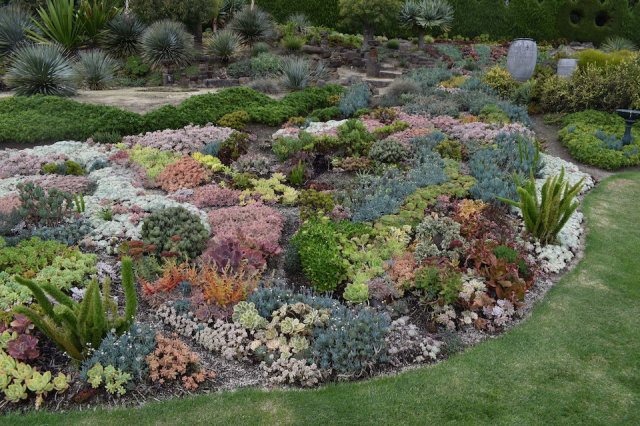
As the ‘river’ flowed down the hillside we came to another Aloe that we recognised, Aloe plicatilis (Fan Aloe). We have one in a pot at home.

In the distance it appeared that the ‘river of plants’ actually flowed into the lake below. It’s a lake shared by the residents and walkers from nearby.

This group of plants growing below the grasses fascinated us. They’re Aeonium tabuliforme (Dinner Plate Aeonium), and they grow best horizontally and not in direct sun.

There were a couple of paved areas. Even there more succulents could be seen growing in pots of various sizes and shapes.

There were some miniature plants growing in pots of water.

Next we started to walk through a relatively barren section. Attila referred to it as the ‘Desert’. Desert or not some groundcovers and a couple of spiky plants were surviving here in amongst a few bones! On closer inspection of the groundcover plants we recognised one. We have actually had a few spreading in a barren dirt section of our garden. Unfortunately we thought they were weeds and had been pulling them out. Oops! Next time we see them we may let them keep growing.
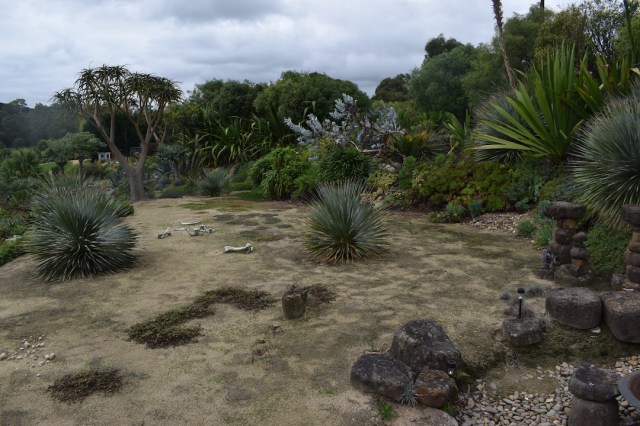
By now we had seen just about the whole garden and were coming to the end of the gravel path.

Right at the end we came to another Aussie native plant, Acacia aphylla, that we recognised. We had one in our garden at one point but it had died. It is a native succulent that flowers but doesn’t have leaves, only succulent like branches. There was a little patch of them growing here. It would appear that they had self sown from seeds that had dropped off a bigger plant into the gravel. At the bottom you can see the juvenile leaves which are totally different to how the plant eventually grows.
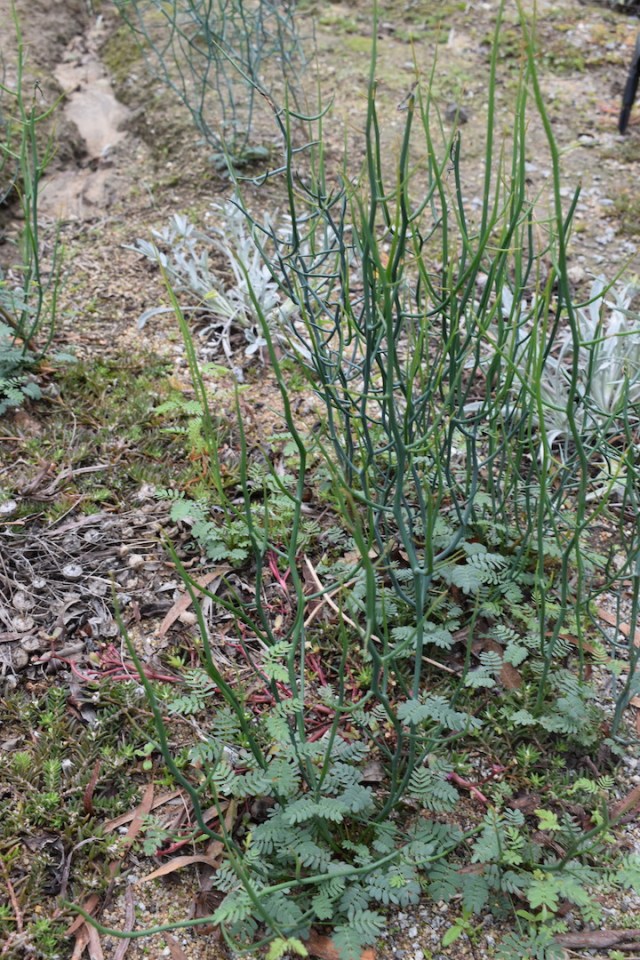
On closer inspection of one of them I spotted a small creature.

Next up Karen and Laura took a look at the plant tables near the gate and ended up buying some cuttings to add to their succulent pot collections.
Shopping completed, we sat in one of the lawn areas and ate our picnic lunches. As they chatted I wandered back around the garden and took a few more photos of some of the scenery. I really liked his stone ruins. It’s amazing what can grow next to rock.

Here’s a secret pond area.

Finally a couple of bright coloured flowers


and a cluster of cacti in pots.

It had been a truly fascinating garden to wander around. As climates around the world change I suspect we will have to look for plants that can handle hotter, drier conditions. So it had been interesting to see different possibilities.
For more information about this unique garden click here.

What a beautiful garden and your photos give it credit also.
On the places to go to list for me.
See you soon.
S and C xx
LikeLike
Thanks for your comment. It was a fun place to take photos at the same time as appreciating all the work to make this garden what it is. Cheers, Mark
LikeLike
Absolutely beautiful garden, I would love to wile away an afternoon here 🙂
LikeLiked by 1 person
I’m in awe, what a stunning garden. Thanks for sharing.
LikeLiked by 1 person